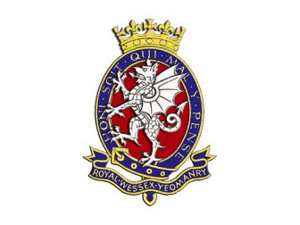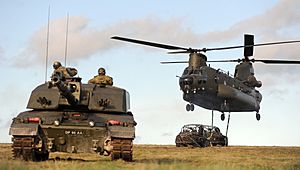Royal Wessex Yeomanry facts for kids
Quick facts for kids Royal Wessex Yeomanry |
|
|---|---|

Cap badge of The Royal Wessex Yeomanry
|
|
| Active | 1 April 1971 – present |
| Allegiance | |
| Branch | |
| Type | Yeomanry |
| Role | Armoured Reinforcement |
| Size | One regiment |
| Part of | Royal Armoured Corps |
| Headquarters | Allenby Barracks, Bovington Camp, Dorset, England |
| Nickname(s) | Wessex Warriors |
| March | Slow: Scimitar Hill ( Sherborne) Quick: God Bless the Prince of Wales |
| Mascot(s) | Ramrod Darcy III, Dorset Ram |
| Commanders | |
| Current commander |
Lt Col A E Sharman |
| Royal Honorary Colonel | The Duke of Edinburgh |
| Honorary Colonel | Simon Hart MP |
The Royal Wessex Yeomanry is a special part of the British Army. It is a reserve unit, meaning its soldiers train part-time. They are an armoured regiment, which means they work with tanks.
This regiment has five groups called squadrons. Their main job is to support the regular army's tank regiments. They make sure there are enough trained soldiers to operate main battle tanks.
Contents
History of the Royal Wessex Yeomanry
The history of this regiment goes back a long way. It started on June 4, 1794. At that time, gentlemen in Devizes decided to create ten groups of soldiers called Yeomanry. This group became the Royal Wiltshire Yeomanry.
The Wessex Yeomanry was officially formed on April 1, 1971. It brought together parts of the Royal Wiltshire Yeomanry, the Royal Gloucestershire Hussars, and the Royal Devon Yeomanry. On June 8, 1979, the Queen gave them the "Royal" title, and they became the Royal Wessex Yeomanry.
At first, they were trained as infantry (foot soldiers). But in the 1980s, their role changed. They became a reconnaissance regiment, meaning they would scout ahead to gather information.
In July 1999, they joined with the Dorset Yeomanry. Their job changed again to what it is today.
Training with Challenger 2 Tanks
Since 2013, the Royal Wessex Yeomanry has been the only Armoured Reinforcement Regiment in the UK. This means they provide extra support for the main tank regiments. They help train soldiers to operate the Challenger 2 main battle tank.
All five squadrons in the regiment train soldiers to be Challenger 2 crewmen. They practice driving these tanks in places like Bovington and Salisbury Plain. They also do live firing exercises with the tanks.
Each squadron keeps the traditions of its older regiments. This helps them feel proud of their history. In 2011, they celebrated 40 years since the Royal Wessex Yeomanry was founded. The Duke of Edinburgh, who is their Royal Honorary Colonel, visited them. He met the soldiers and their families.

Joining the Royal Wessex Yeomanry
Like other British Army regiments, the Royal Wessex Yeomanry welcomes recruits from all over the country. However, they traditionally recruit from counties in the southwest of England. These include Devon, Dorset, Gloucestershire, Shropshire, and Wiltshire. They also welcome people from nearby counties like Cornwall, Hampshire, Oxfordshire, and Somerset.
How the Regiment is Organised
The Royal Wessex Yeomanry is made up of different squadrons. Each squadron keeps the name of its original county Yeomanry regiment.
- Regimental Headquarters, at Allenby Barracks, Bovington Camp
- A (Dorset Yeomanry) Squadron, at Allenby Barracks, Bovington Camp
- B (Royal Wiltshire Yeomanry) Squadron, at Army Reserve Centre, Old Sarum
- C (Royal Gloucestershire Hussars) Squadron, at Army Reserve Centre, Cirencester
- C (Cassino) Troop, at Venning Barracks, Donnington
- D (Royal Devon Yeomanry) Squadron, at Wyvern Barracks, Exeter
- Barnstaple Troop, at Fortescue Lines, Barnstaple
- Y (Royal Wiltshire Yeomanry) Squadron, at Army Reserve Centre, Swindon
It's interesting that B Squadron is the oldest squadron in the regiment. This is because the Royal Wiltshire Yeomanry, which it comes from, was formed way back in 1794.
The Duke of Edinburgh is the Royal Honorary Colonel of the Royal Wessex Yeomanry. This is a special role where he supports the regiment.
Uniform and Symbols
The Royal Wessex Yeomanry has a special patch called a Tactical Recognition Flash (TRF). This patch is worn on their uniform. It used to have a broken spur symbol. This symbol showed that the units were once horse-mounted but later became infantry.
The colors of the TRF came from the old regiments. In 2016, the colors changed, and the broken spur became a complete spur.
The regiment wears a brown beret, which is a type of hat. They also have a black patch behind their cap badge. This patch shows their connection to the Royal Tank Regiment.
Until 2014, each squadron wore the cap badge of its original Yeomanry regiment. This meant the Royal Wessex Yeomanry had four different cap badges! But on July 5, 2014, all squadrons started wearing one single cap badge. This new badge features the white dragon of England.
Regimental Connections
The Royal Wessex Yeomanry has special connections with other military units:
- The Queen's Royal Hussars
- The King's Royal Hussars
- The Royal Tank Regiment
- HMS Enterprise (a ship in the Royal Navy)
Leaders of the Regiment
Here are some of the commanding officers who have led the Royal Wessex Yeomanry:
- 2003–2005: Lt Col The Lord de Mauley
- 2005–2007: Lt Col M.J.R. Rothwell
- 2007–2010: Lt Col R. Frampton-Hobbs
- 2010–2012: Lt Col R.B. Trant
- 2012–2015: Lt Col C. MacGregor
- 2015–2017: Lt Col J. Godfrey
- 2017–2020: Lt Col R.A. Burdon-Cooper
- 2020–2022: Lt Col C.J. Speers
- 2022–Present: Lt Col A.E. Sharman
Honorary Colonels
These are important people who have held the honorary role of Colonel for the regiment:
- 1971–1984: Col The Duke of Beaufort
- 1984–1989: Maj The Baron Margadale
- 1989–1992: Maj Gen Sir Sir J.H.B. Acland
- 1992–1997: Gen Sir C.J. Waters
- 1997–2000: Col J.E. Baring Hills
- 2000–2003: Lt Col J.G. Peel
- 2003–2010: Maj Gen A.G. Denaro
- 2010–2015: Gen Sir A.R.D. Shirreff
- 2015–2022: Lt Col The Lord de Mauley
- 2022–present: Mr S.A. Hart
Order of Parading
When British Army regiments parade, they line up in a specific order. This is called the order of precedence. The unit on the far right is considered the most senior.
| Preceded by Royal Yeomanry |
British Army Order of Precedence |
Succeeded by Queen's Own Yeomanry |

